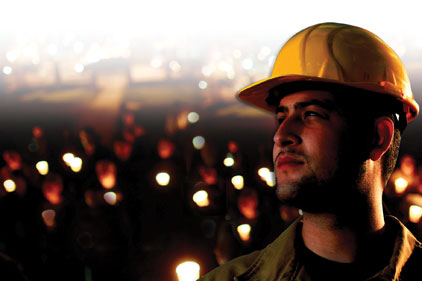An acceptable loss is a sacrifice that is deemed an acceptable cost of doing business.
The U.S. public is in no mood to fight for further worker health and safety improvements. Today, an unspoken consensus exists: an acceptable level of risk and human loss in the country’s workplaces has been reached. There is no outrage, outside of the unions, no protests, little activism, and worst of all, no vision for worker safety articulated
on a par with environmentalism. President Obama in his 2012 Earth Day Proclamation succinctly stated the environmental stakes: “to leave our children a safe, sustainable future.”
Our national disinterest in workplace safety and health is nothing new. During construction of the Panama Canal from 1904 to 1914, about 5,600 U.S. workers died of disease and accidents. (About 22,000 French workers died of disease and accidents prior to the U.S. takeover of canal construction.) There’s no record of public outcry or Congressional inquiries. Out of sight, out of mind.
In 1912, according to the National Safety Council, 18,000-21,000 workers died of work-related injuries in the U.S. In 1913, the Bureau of Labor put the toll at 23,000. Again, no protests, no investigations, save for muckraking journalists. The need for jobs for millions of arriving immigrants trumped safety. Nine million immigrants arrived in the U.S. between 1900-1910. After World War II, much of the working class climbed into middle class suburban comfort. Again income trumped safety. The 1970s proved a wild and woolly time, with newly-born OSHA rolling out standards left and right and conducting upwards of 70,000 to 80,000 inspections annually. Business was outraged, a “STOP OSHA” campaign was launched, unions counterattacked in defending and advocating for standards, but the public? It sat on the sidelines, silent.
Since then, OSHA has faded dramatically (issuing one standard every eight years on average, inspections half of those in the ’70s, and generous penalty settlement agreements anywhere from 40% to 90%, according to one compliance officer who requested anonymity for this article). Declining fatality (20 years ago 6,217 workers died on the job) and injury rates have muted any sense of urgency. Mainstream media is disinterested and disconnected from blue-collar America (little subscription potential). Washington lawmakers have failed to pass any significant workplace safety and health laws. Both the White House and the Department of Labor have failed to set any goals for improving workplace safety and health. Only catastrophes like the Deepwater Horizon blowout and the Upper Big Branch mine collapse briefly capture the public’s eye.
Imagine if President Obama in his Workers’ Memorial Day Proclamation this past April committed to cutting workplace fatalities and injuries in half by 2025, something akin to President Kennedy committing to putting a man on the moon by the end of the 1960s. Safety and health pros know the galvanizing effect of setting goals, but Presidents rarely talk about worker safety, let alone raise the stakes (and business costs) by proclaiming goals.
Unlike environmentalism, there are not millions of students, teachers, activists, and elected officials demanding a healthy future for generations of workers to come. The work that takes place inside offices, factories, warehouses, on rails, shipping lanes, and interstates, on construction sites and farms and ranches does not threaten vulnerable children, save for farming. The public’s distance from workplace risks is a major reason for its acceptance of a death toll that is empty of any personal associations, except in the case of victims’ families. EPA has a budget 15 times the size of OSHA’s because environmentalism enjoys public and political support, grassroots activism, and media attention OSHA can only dream of. Air pollution, water pollution, lead poisoning, Superfund sites, and hazmat spills are not distant threats; they threaten backyards and communities. For the public, that’s too close.
To be sure, not everyone has succumbed to the concept of acceptable workplace injury and illness losses. Not union safety and health leaders like Bill Borwegen, Mike Wright, Jim Fredericks, Eric Frumin, and Peg Seminario. Not activists like Ralph Nader (still), Garrett Brown, Ron Hayes, Billy Robbins, Celeste Monforton, Liz Borkowski, Nancy Lessin, Michael Silverstein, Mary DeVany, Andrew Cutz and Joel Shufro. Not OSHA bureaucrats like Charles Adkins and Mike Connors, nor agency political appointees such as Dr. John Howard, Jordan Barab, Deb Berkowitz and Dr. David Michaels.
They possess the passion, but wield little power (small budgets, no great numbers of followers, limited access to the media and lawmakers).
The professional safety and health societies have not remained silent. This year began with ASSE sending out a press release with President Terrie Norris declaring: “A statistical plateau of worker fatalities is not an achievement, but evidence that this nation’s effort to protect workers is stalled. These statistics call for nothing less than a new paradigm in the way this nation protects workers.”
But who will bankroll a new paradigm? Institutional advocates of workplace safety are clearly stunted by a lack of funding. OSHA ($564 million), the Chemical Safety Board ($13 million), MSHA ($384 million), and NIOSH ($128 million) have mere pocket change for budgets, compared to EPA’s $8.3 billion budget.
Public apathy does not extend to several thousand corporate cultures. Many fly the OSHA Voluntary Protection Program flag. Others spend five, six or seven-figures annually on high-end consulting services such as DuPont Sustainable Solutions, BST/DEKRA, ORC/Mercer, Aon, DNV, and BSI America. An army of small, often one-man-band EHS consultants, some very profitable, serve the middle market. The low-end, made up of millions of small shops and contractors, goes largely unattended, and is where many of the injuries and fatalities occur.
But since the Great Global Recession of 2008 to 2012, corporate money and manpower for EHS initiatives is tight, especially beyond the multinationals and their global EHS management systems. “We need to remind businesses that they should not cut back on occupational safety and health systems,” ASSE President Norris said. “If they do, it will come back to severely haunt them in the future in the guise of increased health care and workers’ comp costs, production delays, reputation damage and much, much more.”
Still, according to ISHN’s 2012 White Paper reader poll, one in five EHS pros face budget cuts in this year; 12% will make do with smaller staffs; 44% will work longer hours and 46% say they will take on more work and more stress.
“I see EHS continually being pushed to operate on less and less money,” says safety manager Dan O’Brien.
The scramble for EHS resources is another consequence of the nation’s disinterest in workplace injuries and deaths. Public pressure on companies to improve safety and health is just about nil. But the power of public pressure becomes clear when giants like Apple and Nike lose control of workplace safety and health in their global supply chains, and the media jumps on stories such as the wave of worker suicides at Foxconn, a Taiwanese Apple supplier. The U.S. public it seems cares more about protecting its popular brands than its homegrown workforce.
Beg to differ
Not all EHS experts agree that lives lost in the workplace are passively accepted by the public. “Perhaps the current moment is just a pause while we digest prior safety improvements and focus on other areas of life that haven’t improved as much, or have gone downhill,” says Dr. Peter Sandman, a preeminent risk communications specialist.
“I frankly don’t believe there’s a national consensus that we’ve reached an acceptable level of safety,” says Daniel Shipp, president of the International Safety Equipment Association. Why? “Because people just don’t think that much about it at all,” says Shipp.
“The issue of safety and health in the workplace has never been one of ‘America’s National Worries’ even when there was no OSHA,” says EHS consultant James Leemann, Ph.D.
“There is an air of acceptance for those enterprises that are striving to be average,” says Dr. Richard Fulwiler, former director of safety and health worldwide for Procter and Gamble. “But I disagree with the premise when it comes to those enterprises that are striving to be world class or excellent.”
Feeling the pain
There is no “air of acceptance” for families of the 4,690 workers killed on the job in 2010. After the initial shock, many are frustrated and depressed because they cannot get answers from authorities such as OSHA, and they have very few avenues to vent their pain and anger if the employer tries to escape blame.
“I don’t sleep. I’m running on adrenalin all the time. I’m always drugged out,” says Tammy Duncan, whose 20-year-old son Kerry Edward was electrocuted on a job in West Virginia in 2010. “He was my best friend. The day he died I felt completely lost. They said he was on drugs, and our family would have been destroyed if not for all of us fighting to clear his name.”
The U.S. has bought all the safety and health improvements at work the public thinks necessary in part because most Americans and the New York-Washington media rarely cross paths with the likes of Tammy Duncan in rural West Virginia. Workers most likely to die on the job live on the fringes of modern American society: fishing workers, logging workers, aircraft personnel, farmers and ranchers, miners, roofers and trash collectors.
Personal proximity to risk matters. It is a reason the wars in Iraq and Afghanistan have dragged on. The death toll does not sear the hearts and minds of most Americans. The total numbers are low. According to icasualties.org (Iraq coalition casualty count) from 2003-2012, 4,486 American deaths occurred in Iraq, slightly less than the number who died in the workplace in one year. From 2001-2012 in Afghanistan, 1,958 Americans have died. Too few Americans have crossed paths with casualties of the Iraq and Afghanistan wars. The proximity of risk, once so close with the 2001 terror attacks, is now half a world away and seemingly shrinking.
The Vietnam War, in contrast, touched (and tormented) many more families. Of the total 58,269 deaths, 68% occurred between 1967-1969. The high concentration of blood and body bags couldn’t be ignored. It was televised nightly. And the military draft put most teenage boys at risk. The public’s close proximity to risk, and its fear and anger, resulted in mass rallies, sit-ins, protest marches, a near civil war, and a lame-duck president (Johnson).
But large-scale losses do not always translate into national grief and uprisings. Motor-vehicle deaths in the month of February, 2012 totaled 5,280 — more than the number of workers killed in a year. On average, about 45,520 deaths in the United States are related to motor vehicles crashes every year. That’s close to the death toll in Vietnam in a war that spanned more than a decade. But there are no sit-ins, protest rallies and marches to make our highways safer. The public accepts 45,000 highway deaths each year. Why? Proximity of risk is close at hand, every time someone takes the wheel. Most people know someone who has had a crash in the past year (out of 3,158,000 crashes), even if few know of someone who died in a crash.





